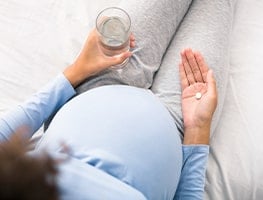When is the best time to get pregnant in a woman’s cycle?
Getting pregnant is all about timing. Having sex as close as possible to the moment of ovulation (when an egg is released from your ovaries) is the best time to get pregnant and will give you the best chance of a successful conception
Your egg usually lives for just 12 to 24 hours, but sperm will live inside you for anything from a few hours to seven days, depending on sperm health.
The best time to get pregnant is in the first few hours after your ovary releases an egg (ovulation) so, to optimise your chances for conception, plan sex so that ovulation occurs when the greatest number of sperm are alive and swimming towards the fallopian tube.
If you have sex the day before ovulation, there’s a good chance that lots of sperm will have made it to your fallopian tubes, ready for the release of the egg.
Under the right conditions, the best-swimming sperm can swim through the cervix into the womb in around two minutes – a feat worthy of Chad le Clos, when you consider their size and the distance they have to travel.
But, because a small number of sperm are long-living, having sex up to six days before ovulation can also result in pregnancy.
The most important information you need to have, if you are planning to have a baby, is a good understanding of your own cycle – and when you are likely to ovulate.
What biological changes happen in my body around the best time to get pregnant?
From puberty until menopause, the body of a fertile woman will go through a regular cycle (averaging 28 days) where it prepares for pregnancy.
If conception does not occur shortly after ovulation, the unfertilised egg passes out of the body – and the whole process is repeated, getting ready for the next egg.
Following menstruation, your body’s hormone levels begin to rise. As the days progress, the walls of your uterus thicken and become engorged with blood, preparing for the implantation of a fertilised egg.
There is also a change in vaginal mucus; as the time of ovulation nears, the mucus becomes thin, stretchy, slippery and clear (a bit like an egg-white) and goes through chemical changes designed to help sperm to swim rapidly towards the fallopian tubes.
Ovulation normally occurs at the same time each month, theoretically in the middle of your cycle, so in a stock-standard 28-day cycle, ovulation will (in theory, again) occur on the 14th day after menstruation.
Around 20 % of women are thought to experience ovulation pain.
The increased levels of the hormone progesterone will cause a rise in your body’s basal (resting) temperature – of anything from around 0.2 to 1.6 °C – just after ovulation, to create a more receptive environment for implantation.
This slightly elevated body temperature happens after ovulation. Most fertility experts think it’s not likely you can fall pregnant once your temperature has risen – it’s often only useful to give you an idea about when ovulation occurred.
You will still have a higher basal temperature until your progesterone levels drop around 10 days later, triggering menstruation.
The rise in your body temperature, combined with the changes in cervical mucus, are important indicators of the stages of your body’s cycle.
What ages offer the best time to get pregnant? Is peak fertility the same for men and women?
Fertility in women is all about the eggs. Most women are in their main reproductive period from the ages of 20 to 38, with the first seven years the most fertile years of this life stage.
But, while women are physically capable of carrying a baby well into their forties (and even fifties), their chances of releasing eggs that will sustain a successful pregnancy will generally decline after the age of 35.
Between the ages of 20 and 27, our eggs and our fertility levels are at their peak. But up to the age of 35, while egg quality will decline slightly, women are still in a period of high fertility. Each year after 35, however, there is a significant decline in the quality of the eggs.
Peak fertility for men is normally early to mid-twenties but, while men do experience age-related fertility decline, it is not as universal as that of women.
When high-profile men father children in their seventies and beyond, it’s often – wrongly – assumed that men remain fertile as they age, despite significant research to the contrary.
From thirty, a man’s levels of the hormone testosterone (necessary for the maturation of sperm) begin to reduce slowly. After the age of forty, men’s testes start to shrink and the quality and quantity of the sperm that they produce slowly declines over time.
























